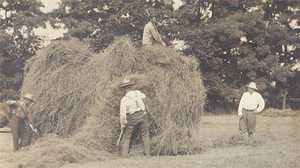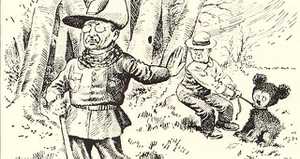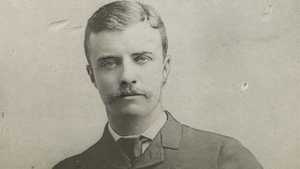Interview: Walter LaFeber
Historian Walter LaFeber comments on aspects of Theodore Roosevelt's career.

The Roosevelt Corollary
When Roosevelt goes into Santo Domingo in 1904-1905, he has to provide some kind of public justification. I don't think it's just a justification. I think Roosevelt really sincerely believed that what he was doing was right and that it was in line with American historic precedent.
But what he says in a message to Congress is that the United States has the right to exercise international police power, and that particular message becomes known as the "Roosevelt corollary to the Monroe Doctrine."
The Monroe Doctrine of 1823 said, as President Monroe issued it in that year, that Europeans should stay out of Latin America, that the Americas were essentially an American preserve. People should stay out of Latin American affairs. What Roosevelt says in 1904 and 1905 is to say, the United States should get into Latin American affairs. He essentially turns the Monroe Doctrine on its head and says the Europeans should stay out, but the United States has the right, under the doctrine, to go in in order exercise police power to keep the Europeans out.
It's a very neat twist on the Monroe Doctrine, and, of course, it becomes very, very important because over the next 15 to 20 years, the United States will move into Latin America about a dozen times with military force, to the point where the United States Marines become known in the area as "State Department troops" because they are always moving in to protect State Department interests and State Department policy in the Caribbean. So what Roosevelt does here, by redefining the Monroe Doctrine, turns out to be very historic, and it leads the United States into a period of confrontation with peoples in the Caribbean and Central America, that was a really important part of American imperialism.
The Panama Canal
The United States had been interested in the canal since the middle of the 19th century and it was only a matter of time until the United States or some power was going to build a canal across the isthmus in Central America. The real question was whether it would go across Panama or whether it would go across Nicaragua.
Roosevelt believed that the United States had to build this canal and, moreover, he believed that the United States had to defend the canal. When the United States made a treaty -- when he was vice president actually, made a treaty with Great Britain which gave the United States the right to construct the canal but not defend it, Roosevelt came out against that treaty. And he essentially, along with others, forced the United States to renegotiate that treaty so the United States would have an absolutely free hand in dealing with the building of a canal in Central America.
Roosevelt believed the canal was of great importance because the distance at that time from New York to San Francisco -- you had to go around the tip of South America -- was something like 13,600 miles. And in order to move the American fleet from the Atlantic to the Pacific in case there was a war, say, with Russia or Japan in the Pacific, would take an extraordinary amount of time. With the canal, the distance is reduced to about 5,000 miles. And Roosevelt saw this instantly as not only a tremendous boon as far as American commerce was concerned, but it would be a way of shifting the American fleet and keeping the fleet together from the Atlantic to the Pacific, or back, depending upon where the fleet was needed. As far as Roosevelt was concerned then, the building of a great navy, the United States entry into this imperial race, and the building of a canal were all parts of the same foreign policy. And without the canal, the rest of the foreign policy would not fall into place.
If you were taking bets in 1902-1903, where an isthmian canal would have been built, you would have probably bet on Nicaragua. That seemed to be the best place to build a canal because of the lakes that were already there ready to take ships. And in 1902-1903, the United States did move towards Nicaragua, but then there was a volcanic explosion in Nicaragua and the people who had an interest in building the canal in Panama took advantage of this to convince the United States Senate that Nicaragua was much too dangerous a place to build a canal.
The people who did this were people from New Panama Canal Company. They were essentially a French group, although they had an American lawyer, William Nelson Cromwell, as their American representative. And the canal company and Cromwell worked very hard in 1903 in order to convince the United States Senate to build the canal through Panama. They did so because there was about $40 million in it for them if they could get the canal built through Panama. The United States would have to buy the rights for that canal from this Panama Canal Company. Roosevelt was willing to go along with this. Roosevelt was willing to go along with anything where he could get a canal built and built as rapidly as possible. And so in 1903 he ordered his Secretary of State, John Hay, to make a treaty with Colombia, which owned Panama. Panama was a province of Colombia.
The Hay-Heran Treaty of 1903 was the treaty that was to give the United States the rights to build a canal in Panama. The Colombian government, however, rejected the treaty. They did it for several reasons, I think. One was, because the United States insisted upon having a tremendous amount of power in their province of Panama, in part because it was clear that the Colombian legislature wanted some of that $40 million and the United States was not going to allow the Colombians to have any part of that $40 million. And so, as a result, the Colombians turned this down and Roosevelt immediately thought that what he -- what was happening here was that he was being shaken down by the Colombian legislature and he called them all kinds of names. Among them, he called them "foolish and homicidal corruptionists," and that was one of the weaker phrases that he used in describing these people. And he was determined he was going to circumvent, he was going to take an end run around the Colombian legislature and build this canal himself. If the Colombians would not give him permission, there were other ways of doing it.
The Colombians finally rejected the treaty that the United States had negotiated with them so that United States could build a canal. The Colombians did this because they did not like the parts of the treaty which allowed the United States to have tremendous power in the canal. For example, there would be American courts in the canal zone, not Colombian courts. But Roosevelt came to the conclusion that the real reason why the Colombians turned this down was because the Colombians wanted some of that $40 million that the Panama Canal Company had. The canal company that had rights to build the canal since the 1880s and the 1890s was now going to be bought out for something like $40 million. The Colombians said, "Why pay the Panama Canal Company that money? Pay us that money." And Roosevelt said he was not going to be shaken down for that kind of money. The Colombian government then, essentially holding out for more money from the United States -- that's what it came down to -- and fearful that the United States was going to be the sovereign power instead of Colombia in the Panama province...
Once the Colombians turn down the treaty, Roosevelt turns to plan number two, I guess it might be called. And that is that he knows the Panama Canal Company, this French group, is very interested in working with Panamanian nationals in fomenting a revolution in Panama. The Panamanians had actually rebelled against Colombia a number of times in the late 19th and early 20th century, and U.S. ships had actually moved in to help referee these bouts between the Panamanian nationals and the Colombians.
So Roosevelt knew there was a great deal of unrest and he knew that the French canal company, whose main spokesman was a very interesting scoundrel named Philippe Bunau-Varilla, that Bunau-Varilla was ready to help lead this revolution. Bunau-Varilla spent a lot of time in Washington in the fall of 1903. He talked to Roosevelt, he talked with Secretary of State Hay, and when he wasn't talking the them, his legal counsel in the United States, a wonderful man named William Nelson Cromwell, was operating behind the scenes in order to expedite this revolution. In the late fall of 1903, the French canal company of Bunau-Varilla understood from Roosevelt and Hay that there would be U.S. ships in the vicinity of Panama, and this seemed to be a very good time for the Panamanians to rise up against Colombia in this kind of spontaneous revolution. This is what happened.
And when the Colombians tried to land troops to put down the revolution in the fall of 1903, the United States citizens who ran the Panamanian railway across the Isthmus of Panama refused to transport the Colombian troops. And then the United States naval commander, under U.S. orders, essentially used force to keep the Colombian troops from moving into Panama to put the rebellion down. So what happened was that Roosevelt said that this was a revolution by Panamanian nationalists against Colombia. What it was also was that the United States had essentially used the United States Navy and its presence in the Panamanian isthmus to make sure that the Colombians could not put down this revolution.
And once the Panamanians were in power and the Colombians were removed, Roosevelt then turned around and made a deal, interestingly, not with the Panamanians, but with Philippe Bunau-Varilla, the Frenchman, and signed a treaty which gave the United States the area of the present Panama Canal and gave the United States sovereignty within the canal area, or, as Secretary of State Hay called it, "residual sovereignty" within the area. He did not sign this with the Panamanians. He signed it with the French canal company.
And the French canal company and Roosevelt and the United States naval commanders then went into Panama and essentially set up Panama the way they wanted, including, by the way, when the Panamanian military, who had been involved in this uprising, began to look to be a little bit too dangerous for U.S. interests, the United States went out and simply bought off these military, gave them $25 or so and sent them back home. And the United States then was able to take over the military defense of Panama as well as the political possession of Panama.







